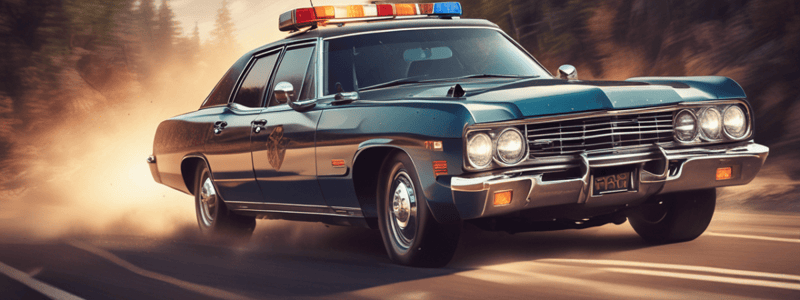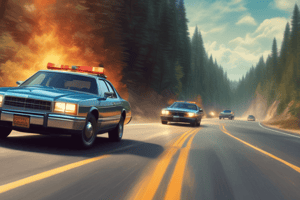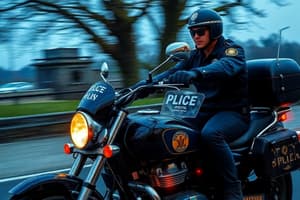Podcast
Questions and Answers
What is the primary goal of threshold braking?
What is the primary goal of threshold braking?
- To engage the anti-lock braking system (ABS)
- To maintain maximum pressure throughout the braking process
- To come to a complete stop as quickly as possible
- To avoid locking up the wheels (correct)
What is the advantage of the 9 and 3 steering technique?
What is the advantage of the 9 and 3 steering technique?
- It is best for gradual turns
- It provides quick access to dashboard control items (correct)
- It allows for faster turns
- It is used for low-speed driving
What is the correct Line of Travel through a true apex turn?
What is the correct Line of Travel through a true apex turn?
- Outside-inside
- Outside-inside-outside (correct)
- Inside-outside
- Inside-outside-inside
What is the primary benefit of using the shuffle steering technique?
What is the primary benefit of using the shuffle steering technique?
What is the purpose of the anti-lock braking system (ABS)?
What is the purpose of the anti-lock braking system (ABS)?
What is the true apex of a turn?
What is the true apex of a turn?
On a cloudy day, a siren's audibility tends to?
On a cloudy day, a siren's audibility tends to?
In foggy weather, emergency lights are?
In foggy weather, emergency lights are?
What can decrease the effectiveness of a siren?
What can decrease the effectiveness of a siren?
In a residential area, a siren may be?
In a residential area, a siren may be?
Why might pedestrians not respond to an emergency warning device?
Why might pedestrians not respond to an emergency warning device?
What should you do when approaching another vehicle from the rear?
What should you do when approaching another vehicle from the rear?
When should you not join a pursuit?
When should you not join a pursuit?
Why might an officer decide to abandon a pursuit?
Why might an officer decide to abandon a pursuit?
What should you avoid doing in a pursuit?
What should you avoid doing in a pursuit?
What should you consider before starting a pursuit?
What should you consider before starting a pursuit?
What is the recommended approach for a left turn?
What is the recommended approach for a left turn?
What should an officer avoid when selecting a route during an emergency response?
What should an officer avoid when selecting a route during an emergency response?
What is a key consideration for selecting a route during an emergency response?
What is a key consideration for selecting a route during an emergency response?
What is a benefit of using headlights in conjunction with emergency overhead lights during daylight?
What is a benefit of using headlights in conjunction with emergency overhead lights during daylight?
Why should officers avoid using high beam lamps at night when using emergency lights?
Why should officers avoid using high beam lamps at night when using emergency lights?
What is a key purpose of using emergency warning devices?
What is a key purpose of using emergency warning devices?
Why is route selection often a low priority during non-emergency responses?
Why is route selection often a low priority during non-emergency responses?
What should an officer prioritize during an emergency response?
What should an officer prioritize during an emergency response?
What can affect the audibility of sirens and the visibility of emergency lights?
What can affect the audibility of sirens and the visibility of emergency lights?
Why is it essential for officers to practice route selection during non-emergency driving?
Why is it essential for officers to practice route selection during non-emergency driving?
Flashcards are hidden until you start studying
Study Notes
Techniques for Emergency Driving
- Threshold braking: applying maximum pressure short of lock-up, releasing gradually to avoid lock-up while maintaining maximum pressure throughout
- 9 and 3 Steering: using light finger pressure, heavier pressure with thumb for quick steering needs, body balance, and access to dashboard control items
- Shuffle Steering: avoiding crossing hands by sliding the wheel in small amounts, best for gradual turns
Line of Travel for a True Apex Turn
- The true apex of a turn is the geometric high point on the inside of a turn
- Correct Line of Travel through a true apex turn: outside-inside-outside
- Move to the right side of the roadway for a left turn, and to the left side for a right turn
- Brake in a straight line, coast to the inside at the apex, then accelerate to the outside edge
Route Selection for Emergency Driving
- Factors to consider: traffic density, pedestrian traffic, road conditions, line-of-sight, and weather
- Avoid roads with heavy traffic, pedestrian traffic, and poor road conditions
- Select roads with acceptable line-of-sight conditions and minimal traffic density
- Consider day of the week, road, weather, and visibility conditions
Warning Devices for Emergency Driving
- Emergency warning devices enhance the officer's ability to maneuver in traffic and reduce risk to self and others
- Headlights should be used in conjunction with emergency overhead lights during daylight
- High beam lamps can obliterate emergency lights and blind oncoming drivers during nighttime
- Sirens are often required, by statute, regardless of the time of day when engaged in emergency driving
- Emergency lights and sirens are not substitutes for caution and utilization of mastered driving skills
Safety Techniques for Pursuit Driving
- Common pursuit driving tips:
- Hands should be at the 9 and 3 position on the steering wheel
- Vary the pitch of the siren from time to time
- Seatbelts should be tightened up slightly
- Talk on the radio as little as possible and only on straightaways and in uncongested areas
- Flash lights when approaching another vehicle from the rear
- Know the area and do not depend on the siren to move other vehicles out of the way
- When to abandon a pursuit: if an officer begins to feel or suspect that they are driving over their and the vehicle's limitations
Studying That Suits You
Use AI to generate personalized quizzes and flashcards to suit your learning preferences.




